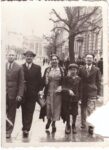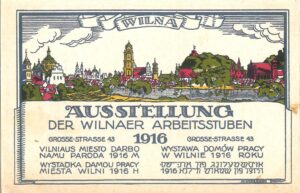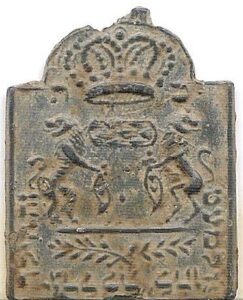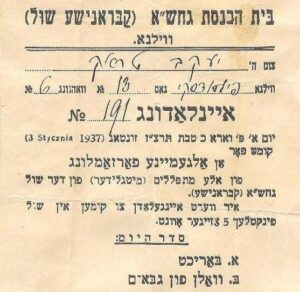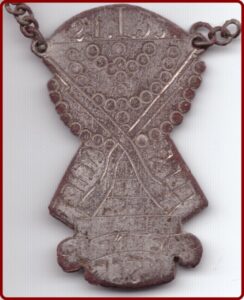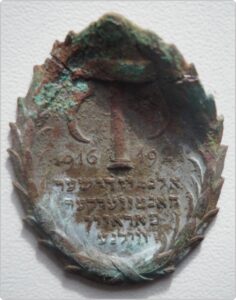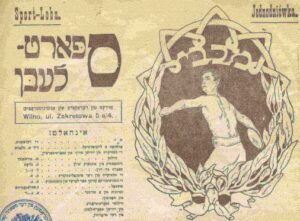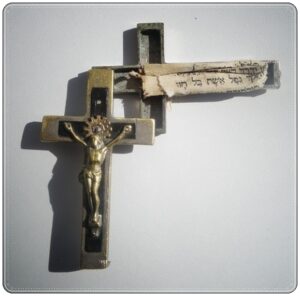◊
by Dovid Katz © 2025
◊
FEATURED:
FORGOTTEN YIDDISH POEM BY VILNA YIDDISH POET HIRSH GLIK;
AVANT GARDE STUDIO INVITES ZALMEN REYZEN TO SHAKESPEARE AND GOGOL SCENES IN YIDDISH
IN ORDER OF UPLOAD
LATEST ACQUISITIONS
See also: JEWISH VILNA. VILNA BOOKSTAMPS. 7 LITVAK KINGDOMS. LITVAK RESOURCES.
◊
See also:
Mini Museum of Interwar Jewish Lithuania
◊
T H E M A T I C I N D E X
People, Institutions, Addresses
Languages of Vilna
Jewish Objects
Drawings in Books
Traditional Religious Jewish Vilna
The Old Jewish Cemetery
The Age of Haskalah (Haskóle)
Yiddish Culture, Literature & Theatre
Yiddish Education
The Vilna Yivo
Jewish Socialism
Zionism
Hebrew Literature and Education
Commerce and Trade Unions
Agriculture
Sports
World War I
Holocaust Era
Soviet Times
Natives and Survivors Remember
◊
C O N T E N T S
People, Institutions, Addresses
1930s photograph with inscription “Don’t forget us” sent by a family of five, posing for photo on central boulevard, to their relatives in Israel (then Palestine)
A Vilna 1843 edition of the classic midrash Médresh Rábe (Midrash Rabba), for the book of Genesis, that belonged to Yisróel son of Avróm ha-Léyvi (Israel son of Abraham the Levite), at the Beys-Yankev (Beth Jacob) study society on Dáytshishe gas (now Vokiečių gatvė), with an indication of the address: Smolenskin’s Yard
A Koenigsberg 1857 edition of a Hebrew work on the commandments that belonged to Chaikel (Khaykl) Lunski (± 1881 — 1942 or 1943), the fabled “guardian of Jerusalem of Lithuania”
Invitation to Jacob Trok to attend the Undertakers Synagogue general meeting on 3 January 1937
On March 6th 1916 the rector of Leipzig University signed a certificate confirming courses followed in law and philosophy by Lazar Epstein of Vilna
Two photos from interwar Vilna of a man, one with his son Shmuel, with Yiddish texts addressed to a sibling
Gabi Weinreich provides details of the old Max Weinreich and Tsemakh Shabad residences in the city
Kháne (Chana) Rudenski’s 1912 Hebrew-Russian Vilna birth certificate, as reproduced by the 1926 chief rabbi, the famed Zionist rabbi Yitzkhok Rubinshteyn, in Hebrew-Polish format, for Wilno authorities to issue a passport
Book dedication by Lemberg (Lvov, Lviv) rabbi, Dr. Shmuel Gutman, written on the title page of his Kóyvets Maamórim (Lemberg 1932), to Vilna rabbi Yitskhok Rubinshteyn
A block of diverse advertisements with addresses of Vilna businesses, in J. Kronenberg’s Náyer Mórgn (1921)
Two metal name plates, for Meyer Berger and Reb Yitskhok Levin
A personal stamp of Isaac [ben] Eliezer; Jewish name with Polish initials
Yiddish-Polish lead kashruth seal of Rabbi S. Segal of Szpitalna (Shpitól gas)
A “Faked” 1851-1852 Book of Leviticus published by Romm on the orders of the Czarist government (at the insistence of its Maskilic Jewish advisors)
1929 collage of six drawings by Ber Horowitz of five Vilna Jewish personalities (A.I. Goldshmid, Tsemakh Shabad, Meyshe Shalit, Sh. L. Tsitron, J. Vigodski, M. Weinreich)
Letter from Tel Aviv philanthropist and Vilna-issue activist Yesháye Epshtein (Yeshayahu Epstein) dated 21 Nov. 2006 on various issues
◊
Languages of Vilna
A World War I German postcard marking a quadricultural-quadrilingual art exhibition, with equal Belarusian, Lithuanian, Polish and Yiddish text under a large German heading
All three Jewish spellings of the name of the Jerusalem of Lithuania found in a single bookbinding: traditional Aramaic Vilno with alef; Yiddishist Vilne with ayin; Hebraist Vilna with hey
Fragment of lead type from a language primer for children containing samples from three Jewish languages, Hebrew, Aramaic and Yiddish, as well as three forms of the alphabet: the square Hebrew and Rashi fonts, and a font conjuring Ashkenazic cursive
A mixed-language ditty (Ashkenazic Hebrew with repeated admixture of one special Yiddish word) serves as the playful handwritten ex-libris of this 1872 Book of Ezekiel and the Twelve Minor Prophets published by Romm in Vilna
Yiddish and Hebrew dialectology, and internal cultural differences, in a poem by the nineteenth century Vilna Hebrew poet Yehuda Leib Gordon (Yalág)
A World War I German postcard marking a quadricultural-quadrilingual art exhibition, with equal Belarusian, Lithuanian, Polish and Yiddish text under a large German heading
World War I bilingual German-Yiddish passport issued by the German occupation authorities in Vilna to Fruma Razanski of Glazier Street 8-2
Bilingual German and Yiddish warning from military commander (1916 or 1917) against providing civilian clothing or otherwise assisting hostile enemy personnel in occupied territory
The 1930 diploma (Yiddish and Polish) awarded by Vilna’s High School of Mathematics and Natural Sciences to Chana Zlatkowicz (Khane Zlatkovitsh)
A personal stamp of Isaac [ben?] Eliezer [?]; Jewish name with Polish initials
A Yiddish-Polish lead kashruth seal of Rabbi S. Segal of Szpitalna (Shpitól gas)
Page from a Yiddish-Polish petition against the League of Nations proposal to reform the calendar
Lead type for a subscription slip for the Vilna Hebrew newspaper Ha-zmán (text in Hebrew, post office address in Russian and German)
Shimshon Meltzer’s Hebrew translation of Méyshe Kúlbak’s poem Vílne
◊
Jewish Objects
An old amulet, in Hebrew, for a newborn child: for a boy to grow in learning of Torah, and for all children to be protected from disease (found by renovators of a flat in the Old Town)
A bottle of Peysakhóvke from Lublin that made its way to 1930s Vilna, where it was found, after waiting some 70 years, in at attic in Zarétshe (Užupis) [English summary]
Remnant of a silver Torah-scroll breastplate (Khoyshn [-míshpet]) donated by Rivke daughter of Shmuel in 1832-1833
Old Vilna mezuzahs from apartments near the railway station
Two Chanukah dreidels (dreydlakh) found by renovators under the floorboards of an apartment on Óshmener gas (today: Ašmenos gatvė) in the old town (and part of the wartime Vilna Ghetto)
A flat Chanukah dreidel (dreydl)
A Yiddish and Polish kashruth lead seal issued by Rabbi S. Segal of Szpitalna (Shpitól gas)
Two (non-matching) kiddish cup saucers found on Little Stefan Street (Raugyklos gatvė)
Two metal name plates, for Meyer Berger and Reb Yitskhok Levin
1928 brooch marking in Yiddish exclusively the 15th anniversary (1913-1928) of the Union of Jewish Business Employees
A 1933 brooch celebrating the 17th anniversary of the tenth section of the Jewish Artisans Union in the Vilna region
Small plate with embedded stars-of-david and other designs
A personal stamp of Isaac [ben?] Eliezer [?]; Jewish name with Polish initials
Medallion of Bund theoretician and leader Vladimir Medem
A letter opener (or spoon or fork?) engraved with the name “M. Katz” spelled in the modernist Yiddishist way
◊
Drawings in Books
Drawing of an eye in a Vilna 1853 edition of Joshua, Judges and the Books of Samuel
Drawing of a house with a table and samovars, and some people and creatures, in a Vilna 1851 edition of a volume of the Mishnah
Drawing in color of a soldier, a name in Russian and another in Hebrew, in a Vilna 1860 edition of the Books of Kings and Chronicles
Drawings of people in a Vilna 1939 student edition of the tractate Kidushin from the Babylonian Talmud that belonged to the pupil Rubinshteyn
◊
Traditional Religious Jewish Vilna
Invitation to Jacob Trok to attend the Undertakers Synagogue general meeting on 3 January 1937
A 1928 placard published by the renowned Ramayles (Ramailes, Reb Maile’s) yeshiva pleading for financial assistance from American brethren. It has the added-in-pen signature of the yeshiva’s head, Rabbi Avrom Tsvi-Hirsh Grodzenski, and the printed signature of the city’s spiritual rabbi, Chaim-Oyzer Grodzenski, providing his address (Zavalna 17, now Pylimo corner of Basanavičiaus)
Yisroel-Tsvi Piesker Announces the Death of Rabbi Pinkhes-Moyshe Gordon of Ramayles Yeshiva (10 Aug. 1917)
A Torah (?) reader at the Zavl Shul (at the confluence of Blúmen gas [now Gėlių] and Sadóve [Sodų]) proudly puts his handwritten ex-libris on the title page of one of his books; nowadays the Zavl Shul, an awesome ruin, is in danger of being knocked down altogether
A list of the popular Yiddish names of 27 of Vilna’s c. 160 synagogues in connection with a Dec. 1921 campaign to raise funds for religious schools of poor pupils
A commentary in Hebrew and Aramaic on two Talmudic tractates, printed in Venice in 1605-1606, with the oldest known stamp design of the Matisyohu Strashun collection in Vilna
A Yiddish-Polish rabbinic lead seal assuring kosherness of the meat
A Yiddish-Polish petition against a League of Nations proposed calendar reform that would have confounded the Jewish Sabbath
A Book on Ghosts and Hell
◊
The Old Vilna Jewish Cemetery (Piramónt)
World War I Postcard of the Grave of Menachem Manes Chayes (1560-1636) in the Old Vilna Jewish Cemetery
◊
The Age of Haskalah (Haskóle)
A “Faked” 1851-1852 Book of Leviticus published by Romm on the orders of the Czarist government (at the insistence of its Maskilic Jewish advistors)
Vilna Scholar Tsvi-Nisn Golomb Writes to Biblical Scholar Salomon Mandelkern in Leipzig (13 Aug. 1890)
◊
Yiddish Culture, Literature & Theatre
1929 collage of six drawings by Ber Horowitz of five Vilna Jewish personalities (A.I. Goldshmid, Tsemakh Shabad, Meyshe Shalit, Sh. L. Tsitron, J. Vigodski, M. Weinreich)
Issue Nº 2 of the Vilna ‘Tog’ (11 May 1919) with An-ski, Novick, Reyzen, Shabad & Weinreich on masthead
A 1925 parody of Moyshe Kulbak’s famous 1916 poem “Shterndl” in the daily Di Tsayt
Chaim Nachman Shapiro’s 1935 book in Lithuanian on Hebrew and Yiddish poetry about the city Vilna
The 22 January 1922 issue of Zalmen Reyzen’s daily, the Vilna Tog, announces an evening in honor of Yiddish author A. I. Grodzenski
Chaim Grade and Tsile Žiburkienė
30th Birthday photo memento (text in Yiddish and German) honoring Nokhem Lipovski (Nahum Lipowski), founder of the Vilna Yiddish Folk Theatre
Max Weinreich’s 1931 review of M. Vorobeichic’s photo volume on Jewish Vilna issued with an introduction by Zalman Shneur
Manuscript (completed 1968) of Mark Razumny’s Motke Khábad
Pages from Líte (Líto), the little collection by Uriah Katzenelenbogen and A. I. Goldsmith published by Kletskin in Vilna (Little Stefan Street 23) in 1914. It has materials on the Lithuanian and Belarusian peoples. The back cover is a ship company’s advertisement for getting to America
A poem by Hirsh Glik on the nightime beauty of Vilna and the Viliya River published in the Soviet daily Vilner émes on 7 February 1941
Avant-garde Yiddish theatre studio invites Yiddish scholar and cultural leader Zalmen Reyzen to scenes from Shakespeare, Schiller, Gorki, Gogol and Büchner (Dec. 1934)
Shimshon Meltzer’s Hebrew translation of Méyshe Kúlbak’s poem Vílne
Medallion of Bund theoretician and leader Vladimir Medem
◊
Yiddish Education
The 1929 Yiddish teaching diploma awarded to Chaim Yavitsh by the Vilna Yiddish Teachers’ Seminary
The 1930 diploma (Yiddish and Polish) awarded by Vilna’s High School of Mathematics and Natural Sciences to Chana Zlatkowicz (Khane Zlatkovitsh), mother of Professor Pinchos Fridberg
Front and back cover of part 3 of Max Weinreich’s authorized translation into Yiddish of Sigmund Freud’s Introduction to Psychoanalysis, published by the Vilna Yivo in 1938
In 1921, The Vina Jewish Community published its Reports, a slim volume heavy on statistics; one table compares the composition of the Vilna Jewish population in 1897 and 1919
Two elite Yiddish educational publishers, Kletskin in Vilna and Levin-Epshteyn in Warsaw, go head-to-head in facing advertisements in a 1922 issue of Bikher velt
1929 collage of six drawings by Ber Horowitz of five Vilna Jewish personalities (A.I. Goldshmid, Meyshe Shalit, Sh. L. Tsitron, J. Vigodski, M. Weinreich — and of himself)
1934 issue of Shleyme Bostomski’s young people’s magazine Der Kháver featuring on p. 1 a photo of the Workmen’s Circle Yiddish school in Atlanta, Georgia
First Issue of Bostomski & Chaimson’s new magazine for Yiddish teachers around the world, the “Shúl-Fraynd” (Vilna, Jan. 1936)
Medallion of Bund theoretician and leader Vladimir Medem
Director of ORT’s Vilna Jewish Technical College recommends Shepsl Ratner of Zelva for physics studies in April 1923
◊
The Vilna Yivo
Issue Nº 2 of the Vilna ‘Tog’ (11 May 1919) including future Yivo founders Z. Reyzen, Ts. Shabad & M. Weinreich on Masthead
The published project for the setting up of Yivo (1925)
Volume 1, no. 1 of Yivo bleter (1931)
Yivo’s artistic perforated Boy-fond (‘building campaign’) card for donors (±1929)
A 1933 postcard from Zalmen Reyzen at the Vilna Yivo to a library in Tel Aviv
Avant-garde Yiddish theatre studio invites leading Yivo scholar Zalmen Reyzen to scenes from Shakespeare, Schiller, Gorki, Gogol and Büchner (Dec. 1934)
Vilna Yiddish Linguist Max Weinreich inscribes — on the Train to Svintsyán (Święciany, Švenčionys), on 10 Dec. 1936 — his famous paper in French, to Tel Aviv Yiddish linguist (& Hebrew Editor) Daniel Leibel
Front and back cover of part 3 of Max Weinreich’s authorized translation into Yiddish of Sigmund Freud’s Introduction to Psychoanalysis, published by the Vilna Yivo in 1938
Gabi Weinreich provides details of the Max Weinreich and Tsemakh Shabad residences in interwar Vílne (Wilno)
◊
Jewish Socialism: The Bund

A packet of Bundist materials found in an attic on Novigóred (Nowogrodzka, today’s Naugarduko St.)
Medallion of Bundist theoretician and leader Vladimir Medem
On March 6th 1916 the rector of Leipzig University signed a certificate confirming courses followed in law and philosophy by Lazar Epstein of Vilna
◊
Zionism
A silver medal issued by the “Menorah” group of the Zionist organization Betar in Vilna, dated 21 January 1933
The 1924 Mizrahi (religious Zionist) youth movement membership card of Ruven Finger
A 1930/1931 Vilna pin in Hebrew celebrating support for the Land of Israel
The lapel pin (medallion) of the fabled Vilna Tarbut (Tarbus) school and gymnasium
Advertisement published 8 August 1919 inviting parents to enroll their children in the Hebrew secondary school (gymnasium) at Zavalna 4 (today’s Pylimo 4)
◊
Hebrew Literature and Education
Advertisement published 8 August 1919 inviting parents to enroll their children in the Hebrew secondary school (gymnasium) at Zavalna 4 (today’s Pylimo 4)
The lapel pin (medallion) of the fabled Vilna Tarbut (Tarbus) school and gymnasium
Nineteenth century Vilna Hebrew Haskalah poet Yehuda Leib Gordon’s poem “The Horse and the Swallow” with proposed Latin letter transcription of the Ashkenazic Hebrew
Three pages from the Hebrew poem Vilna (Ashkenazic rendition: Vilno) by Zalman Shneour that appeared as a book published by S.D. Saltzmann’s “Hasefer” in Berlin in 1923
Chaim Nachman Shapiro’s 1935 book in Lithuanian on Hebrew and Yiddish poetry about the city Vilna
Blank annual report card of the Hebrew Tarbut (Tarbus) school on Zavalna during the interwar period (today the building is Pylimo 4, housing the Jewish Community of Lithuania)
Lead type for a subscription slip for the Vilna Hebrew newspaper Ha-zmán (text in Hebrew, post office address in Russian and German)
◊
Commerce and Trade Unions
1921 brooch marking in Yiddish the 5th anniversary (1916-1921) of the Jewish Craftmens Union
1928 brooch marking in Yiddish the 15th anniversary (1913-1928) of the Union of Jewish Business Employees
Advertisement in the 12 May 1927 edition of Vilner Tog, the daily edited by Zalmen Reyzen, for the exquisite pudding developed by Dr. Etker (Oetker). Even blindfolded, the most discerning client will recognize the unique and wonderful taste…
A block of diverse advertisements with addresses of Vilna businesses, in J. Kronenberg’s Náyer Mórgn (1921)
A 1920 advertisement in Vilna for a Chicago bank and its Warsaw rep
◊
Agriculture

The Lapel Pin (Medallion) of an Agricultural (or Gardening) Institution
◊
Sports
Title page and end page of the “one-time only publication” of Sport lebn (Sports Life), 20 October 1922, including photo of the Maccabee (Yiddish: Makábi) football team, and an ad for the 27 Oct. 1922 “sports ball” at Town Hall to culminate with “dancing until 5 AM”
◊
World War I
World War I bilingual German-Yiddish passport issued by the German occupation authorities in Vilna to Fruma Razanski of Glazier Street 8-2
A World War I German postcard marking a quadricultural-quadrilingual art exhibition, with equal Belarusian, Lithuanian, Polish and Yiddish text under a large German heading
Bilingual German and Yiddish warning from military commander (1916 or 1917) against providing civilian clothing or otherwise assisting hostile enemy personnel in occupied territory
On March 6th 1916 the rector of Leipzig University signed a certificate confirming courses followed in law and philosophy by Lazar Epstein of Vilna
◊
Holocaust Era
Crucifix with (Unverified) Wartime (Hidden) Insert of Page of Hebrew Psalms
Vilna Ghetto Jewish Policeman Issues Order for Release of Chaim Meller from Ghetto Prison (18 March 1942)
Committee for Jewish Refugees of the Lithuanian Red Cross issues certificate (dated 23 Aug. 1940) to Matis Kolinsky (bilingual Lithuanian and Yiddish) about a week after after the Soviet occupation of the city
Mayor of Vilnius Antanas Krutulys and Regional Council president Stasys Žakevičius (Žymantas) order complete lists of Aryan vs. Jewish residents of the city within four days (July 1941)
Some (off-color) graffiti on an old brick that might originate from the 1941-1943 Vilna Ghetto period
◊
Soviet Times
Hand-made Chanukah dreydl from the Stalin years, made around 1950 by Dobke Yonis (born in Zezmer in 1912)
A postcard from Chaim Kravitz in Rishon L’Tzion in the newly established State of Israel, dated 17 June 1948, to Shmaryóhu Kitayevich in Vilna (Vilnius)
Manuscript (completed 1968) of Mark Razumny’s Motke Khábad
◊
Natives and Survivors Remember
Two letters from Professor Gabriel (Gabi) Weinreich (Ann Arbor, Michigan), about details of the old Weinreich apartment, Tsemakh Shabad’s (last) residence, and his own feelings about visiting the city
Chaim Grade and Tsile Žiburkienė
The legacy of Blumke Katz (1913 – 2006) of Svintsyán and Vílne, and why her teacher Max Weinreich would have been unhappy with her final gift
Letter from Tel Aviv philanthropist and Vilna-issue activist Yesháye Epshtein (Yeshayahu Epstein) dated 21 Nov. 2006 on various issues
◊
◊
IN ORDER OF UPLOAD
1
Invitation to Jacob Trok to attend the Undertakers Synagogue general meeting on 3 January 1937
◊
2
World War I bilingual German-Yiddish passport issued by the German occupation authorities in Vilna to Fruma Razanski of Glazier Street 8-2
◊
3
30th Birthday photo memento (text in Yiddish and German) honoring Nokhem Lipovski (Nahum Lipowski), founder of the Vilna Yiddish Folk Theatre
◊
4
Old Vilna mezuzahs from apartments near the railway station
◊
5
Two Chanukah dreidels (dreydlakh) found by renovators under the floorboards of an apartment on Óshmener gas (today: Ašmenos gatvė) in the old town (and part of the wartime Vilna Ghetto)
◊
6
A 1928 placard published by the renowned Ramayles (Ramailes, Reb Maile’s) yeshiva pleading for financial assistance from American brethren. It has the added-in-pen signature of the yeshiva’s head, Rabbi Avrom Tsvi-Hirsh Grodzenski, and the printed signature of the city’s spiritual rabbi, Chaim-Oyzer Grodzenski, providing his address (Zavalna 17, now Pylimo corner of Basanavičiaus)
◊
7
Advertisement in the 12 May 1927 edition of Vilner Tog, the daily edited by Zalmen Reyzen, for the exquisite pudding developed by Dr. Etker (Oetker). Even blindfolded, the most discerning client will recognize the unique and wonderful taste…
◊
8
Chaim Grade and Tsile Žiburkienė
◊
9
A Book on Ghosts and Hell
◊
10
Two (non-matching) kiddush cup saucers found on Little Stefan Street (Raugyklos gatvė)
◊
11
The 1930 diploma (Yiddish and Polish) awarded by Vilna’s High School of Mathematics and Natural Sciences to Chana Zlatkowicz (Khane Zlatkovitsh), mother of Professor Pinchos Fridberg
◊
12
Manuscript (completed 1968) of Mark Razumny’s Motke Khábad
◊
13
Nazi Mayor of Vilnius Antanas Krutulys and Regional Council president Stasys Žakevičius (Žymantas) order complete lists of Aryan vs. Jewish residents of the city within four days (July 1941)
◊
14
On March 6th 1916 the rector of Leipzig University signed a certificate confirming courses followed in law and philosophy by Lazar Epstein of Vilna
◊
15
Front and back cover of part 3 of Max Weinreich’s authorized translation into Yiddish of Sigmund Freud’s Introduction to Psychoanalysis, published by the Vilna Yivo in 1938
◊
16
All three Jewish spellings of the name of the Jerusalem of Lithuania found in a single bookbinding: traditional Aramaic Vilno with alef; Yiddishist Vilne with ayin; Hebraist Vilna with hey
◊
17
A Torah (?) reader at the Zavl Shul (at the confluence of Blúmen gas [now Gėlių] and Sadóve [Sodų]) proudly puts his handwritten ex-libris on the title page of one of his books; nowadays the Zavl Shul, an awesome ruin, is in danger of being knocked down altogether
◊
18
The Yiddish teaching diploma awarded to Chaim Yavitsh by the Vilna Yiddish Teachers’ Seminary in 1929
◊
19
Two letters from Professor Gabriel (Gabi) Weinreich (Ann Arbor, Michigan), about details of the old Weinreich apartment, Tsemakh Shabad’s (last) residence, and his own feelings about visiting the city
◊
20
Three pages from the Hebrew poem Vilna (Ashkenazic rendition: Vilno) by Zalman Shneour that appeared as a book published by S.D. Saltzmann’s “Hasefer” in Berlin in 1923
◊
21
Pages from Líte (Líto), the little collection by Uriah Katzenelenbogen and A. I. Goldsmith published by Kletskin in Vilna (Little Stefan Street 23) in 1914. It has materials on the Lithuanian and Belarusian peoples. The back cover is a ship company’s advertisement for getting to America
◊
22
Nineteenth century Vilna Hebrew Haskalah poet Yehuda Leib Gordon’s poem “The Horse and the Swallow” with proposed Latin letter transcription of the Ashkenazic Hebrew
◊
23
The legacy of Blumke Katz (1913 – 2006) of Svintsyán and Vílne, and why her teacher Max Weinreich would have been unhappy with her final gift
◊
24
In 1921, The Vina Jewish Community published its Reports, a slim volume heavy on statistics; one table compares the composition of the Vilna Jewish population in 1897 and 1919
◊
25
A postcard from Chaim Kravitz in Rishon L’Tzion in the newly established State of Israel, dated 17 June 1948, to Shmaryóhu Kitayevich in Vilna (Vilnius)
◊
26
A Vilna 1843 edition of the classic midrash Medresh Rábe (Midrash Rabba), for the book of Genesis, that belonged to Yisróel son of Avróm ha-Léyvi (Israel son of Abraham the Levite), at the Beys-Yankev (Beth Jacob) study society on Dáytshishe gas (now Vokiečių gatvė), with an indication of the address: Smolenskin’s Yard
◊
27
A Koenigsberg 1857 edition of a Hebrew work on the commandments that belonged to Chaikel (Khaykl) Lunski (± 1881 — 1942 or 1943), the fabled “guardian of Jerusalem of Lithuania”
◊
28
A mixed-language ditty (Ashkenazic Hebrew with repeated admixture of one Yiddish word) serves as the playful handwritten ex-libris of this 1872 Book of Ezekiel and the Twelve Minor Prophets published by Romm in Vilna
◊
29
A bottle of Peysakhóvke from Lublin that made its way to 1930s Vilna, where it was found several years ago in at attic in Zarétshe (Užupis)
◊
30
Drawing of a house with a table and samovars, and some people and creatures, in a Vilna 1851 edition of a volume of the Mishnah
◊
31
Drawing in color of a soldier, a name in Russian and another in Hebrew, in a Vilna 1860 edition of the Books of Kings and Chronicles
◊
32
Drawing of an eye in a Vilna 1853 edition of Joshua, Judges and the Books of Samuel
◊
33
Drawings of people in a Vilna 1939 student edition of the tractate Kidushin from the Babylonian Talmud that belonged to the pupil Rubinshteyn
◊
34
Blank annual report card of the Hebrew Tarbut (Tarbus) school on Zavalna (today the building is Pylimo 4, housing the Jewish Community of Lithuania)
◊
35
Two photos from interwar Vilna of a man, one with his son Shmuel, with Yiddish texts to his sibling
◊
36
Hand-made Chanukah dreydl from the Stalin years, made around 1950 by Dobke Yonis (born in Zezmer in 1912)
◊
37
Kháne (Chana) Rudenski’s 1912 Hebrew-Russian Vilna birth certificate, as reproduced by the 1926 chief rabbi, the famed Zionist rabbi Yitzkhok Rubinshteyn, in Hebrew-Polish format, for Wilno authorities to issue a passport
◊
38
Book dedication by Lemberg (Lvov, Lviv) rabbi, Dr. Shmuel Gutman, written on the title page of his Kóyvets Maamórim (Lemberg 1932), to Vilna rabbi Yitskhok Rubinshteyn
◊
39
An old amulet, in Hebrew, for a newborn child: for a boy to grow in learning of Torah, and for all children to be protected from disease (found by renovators of a flat in the Old Town)
◊
40
Bilingual German and Yiddish warning from military commander (1916 or 1917) against providing civilian clothing or otherwise assisting hostile enemy personnel in occupied territory
◊
41
Some (off-color) graffiti on an old brick that might originate from the 1941-1943 Vilna Ghetto period
◊
42
Fragment of lead type from a language primer for children containing samples from three Jewish languages, Hebrew, Aramaic and Yiddish, as well as three forms of the alphabet: the square Hebrew and Rashi fonts, and a font conjuring Ashkenazic cursive
◊
43
A flat Chanukah dreidel (dreydl)
◊
44
A 1925 parody of Moyshe Kulbak’s famous 1916 poem “Shterndl” in the daily Di Tsayt
◊
45
Remnant of a silver Torah-scroll breastplate (Khoyshn [-míshpet]) donated by Rivke daughter of Shmuel in 1832-1833
◊
46
Title page and end page of the “one-time only publication” of Sport lebn (Sports Life), 20 October 1922, including photo of the Maccabee (Yiddish: Makábi) football team, and an ad for the 27 Oct. 1922 “sports ball” at Town Hall to culminate with “dancing until 5 AM”
◊
47
A list of the popular Yiddish names of 27 of Vilna’s c. 160 synagogues in connection with a Dec. 1921 campaign to raise funds for religious schools of poor pupils
◊
48
A block of diverse advertisements with addresses of Vilna businesses, in J. Kronenberg’s Náyer Mórgn (1921)
◊
49
Two metal name plates, for Meyer Berger and Reb Yitskhok Levin
◊
50
Advertisement published 8 August 1919 inviting parents to enroll their children in the Hebrew secondary school (gymnasium) at Zavalna 4 (today’s Pylimo 4)
◊
51
A 1933 brooch celebrating the 17th anniversary of the tenth section of the Jewish Artisans Union in the Vilna region
◊
52
Chaim Nachman Shapiro’s 1935 book in Lithuanian on Hebrew and Yiddish poetry about the city Vilna
◊
53
Small plate with embedded stars-of-david and other designs
◊
54
Two elite Yiddish educational publishers, Kletskin in Vilna and Levin-Epshteyn in Warsaw, go head-to-head in facing advertisements in a 1922 issue of Bikher velt
◊
55
A 1920 advertisement in Vilna for a Chicago bank and its Warsaw rep
◊
56
A commentary in Hebrew and Aramaic on two Talmudic tractates, printed in Venice in 1605-1606, with the oldest known stamp of the Matisyohu Strashun collection in Vilna
◊
57
A personal stamp of Isaac [ben?] Eliezer [?]; Jewish name with Polish initials
◊
58
95 Years Ago Today: A “Grand Student Concert – Ball” in benefit to the Jewish students at Vilnius University
◊
59
The 22 January 1922 issue of Zalmen Reyzen’s daily, the Vilna Tog, announces an evening in honor of Yiddish author A. I. Grodzenski
◊
60
A World War I German postcard marking a quadricultural-quadrilingual art exhibition, with equal Belarusian, Lithuanian, Polish and Yiddish text under a large German heading
◊
61
A Yiddish & Polish kashruth lead seal issued by Rabbi S. Segal of Szpitalna (Shpitól gas)
◊
62
Page from a Yiddish-Polish petition against the League of Nations proposal to reform the calendar
◊
63
1929 collage of six drawings by Ber Horowitz of five Vilna Jewish personalities (A.I. Goldshmid, Tsemakh Shabad, Meyshe Shalit, Sh. L. Tsitron, J. Vigodski, M. Weinreich)
◊
64
1928 brooch marking in Yiddish exclusively the 15th anniversary (1913-1928) of the Union of Jewish Business Employees
◊
65
Lead type for a subscription slip for the Vilna Hebrew newspaper Ha-zmán (text in Hebrew, post office address in Russian and German)
◊
66
Letter from Tel Aviv philanthropist and Vilna-issue activist Yesháye Epshtein (Yeshayahu Epstein) dated 21 Nov. 2006 on various issues
◊
67
A poem by Hirsh Glik on the nightime beauty of Vilna and the Viliya River published in the Soviet daily Vilner émes on 7 February 1941
◊
68
A silver medal issued by the “Menorah” group of the Zionist organization Betar in Vilna, dated 21 January 1933
◊
69
Avant-garde Yiddish theatre studio invites Yiddish scholar and cultural leader Zalmen Reyzen to scenes from Shakespeare, Schiller, Gorki, Gogol and Büchner (Dec. 1934)
◊
70
The 1924 Mizrahi (Religious Zionist) Membership Card of Ruven Finger
◊
71
1930s photograph with inscription “Don’t forget us” sent by a family of five, posing for photo on central boulevard, to their relatives in Israel
◊
72
1934 issue of Shleyme Bostomski’s young people’s magazine Der Kháver featuring on p. 1 a photo of the Workmen’s Circle Yiddish school in Atlanta, Georgia
◊
73
First Issue of Bostomski & Chaimson’s new magazine for Yiddish teachers around the world, the “Shúl-Fraynd” (Vilna, Jan. 1936)
◊
74
Committee for Jewish Refugees of the Lithuanian Red Cross issues certificate (dated 23 Aug. 1940) to Matis Kolinsky (bilingual Lithuanian and Yiddish) about a week after after the Soviet occupation of the city
◊
75
A 1930/1931 Vilna pin in Hebrew celebrating support for the Land of Israel
◊
76
Shimshon Meltzer’s Hebrew translation of Méyshe Kúlbak’s poem Vílne
◊
77
World War I postcard of the Grave of Menachem Manes Chayes (1560-1636) in the Old Vilna Jewish Cemetery
◊
78
1921 Yiddish brooch celebrating the fifth anniversary of the Vilna Jewish Craftmens Association
◊
79
Max Weinreich’s 1931 review of M. Vorobeichic’s photo volume on Jewish Vilna issued with an introduction by Zalman Shneur
◊
80
Crucifix with (Unverified) Wartime (Hidden) Insert of Page of Hebrew Psalms
◊
81
Issue Nº 2 of the Vilna ‘Tog’ (11 May 1919) with An-ski, Novick, Reyzen, Shabad & Weinreich on Masthead
◊
82
Medallion of Bund theoretician and leader Vladimir Medem
◊
83
The first issue of the Vilna Yivo’s Yivo bleter (Jan. 1931)
◊
84
An artistic perforated Boy-fond card for donors to Yivo (±1929)
◊
85
Founding Proposals leading to the rise of the Yiddish Scientific Institute (Yivo) in Vilna in 1925
◊
86
A 1933 postcard from Zalmen Reyzen at the Vilna Yivo to a library in Tel Aviv
◊
87
A “Faked” 1851-1852 Book of Leviticus published by Romm on the orders of the Czarist government (at the insistence of its Maskilic Jewish advisors)
◊
88
Vilna Yiddish linguist Max Weinreich inscribes — on the train to Svintsyán (Święciany, Švenčionys), on 10 Dec. 1936 — his famous paper in French, to Tel Aviv Yiddish linguist (& Hebrew editor) Daniel Leibel
◊
89
The lapel pin (medallion) of the fabled Vilna Tarbut (Tarbus) school and gymnasium
◊
90
A letter opener (or spoon or fork?) engraved with the name “M. Katz” spelled in the modernist Yiddishist way
◊
91
A packet of Bundist materials found in an attic on Novigóred (Nowogrodzka, today’s Naugarduko St.)
◊
92
The lapel pin (Medallion) of an agricultural (or gardening) institution
◊
93
Director of ORT’s Vilna Jewish Technical College recommends Shepsl Ratner of Zelva for physics studies in April 1923
◊
94
Yisroel-Tsvi Piesker Announces the Death of Rabbi Pinkhes-Moyshe Gordon of Ramayles Yeshiva (10 Aug. 1917)
◊
95
Vilna Ghetto Jewish Policeman Issues Order for Release of Chaim Meller from Ghetto Prison (18 March 1942)
◊
96
Vilna Scholar Tsvi-Nisn Golomb Writes to Biblical Scholar Salomon Mandelkern in Leipzig (13 Aug. 1890)
◊
◊
Compiler’s Note
I am slowly putting online Vilna Jewish keepsakes. The modest collection started from some items kept by my father, poet Menke Katz (1906 – 1991) and is part of the Menke Katz Collection. Most have been found during my years based in Vilna (Vilnius, Lithuania), starting in 1999. Each item is accompanied by a (sometimes minimal) commentary in Yiddish.
It is hoped that the larger collection, comprising books, archives and thousands of hours of recordings, now housed at five locations in three countries, will in the fullness of time find an appropriate permanent home.
Vilnius, 3 September 2013
◊
אַ וואָרט פריער
מיר נעמען ביסלעכווייז אַרויסלאָזן פאַקסימיליעס פון פאַרשיידענע ווילנער אַנטיקל⸗זאַכן וואָס געפינען זיך אין אונדזער פּריוואַטן אַרכיוו אין ווילנע, האָפנדיק אַז עמעצן קען דאָס זיין אינטערעסאַנט.
דער אַרכיוו, אינאיינעם מיט דער ביבליאָטעק און קאָלעקציע רעקאָרדירונגען, טראָגט דעם נאָמען פון מיין טאַטן, דעם יידישן פּאָעט מעינקע קאַץ (1906 ― 1991) און אונדזער משפּחהלע. מען האָפט נאָך אַז די קאָלעקציע, וואָס איז צעזייט און צעשפּרייט איבער פינף ערטער אין דריי לענדער, וועט פאָרט מיט דער צייט מירצעשעם איר תיקון געפינען.
הירשע⸗דוד כ″ץ
ווילנע, פאַר ראש⸗השנה תשע″ד (דעם 3טן סעפּטעמבער 2013)
◊

